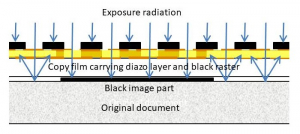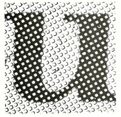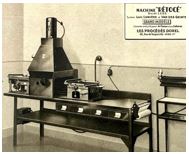Diazo copying in the office
The common use of diazoprinting and diazoprint copying (requiring translucent originals) in the drawing room has made it common practice there to make original drawings on transparent paper.
 This is much less the case in the office. Here, documents are generally opaque and are sometimes printed on both sides. This makes it difficult or impossible to copy office documents with the Diazo method.
This is much less the case in the office. Here, documents are generally opaque and are sometimes printed on both sides. This makes it difficult or impossible to copy office documents with the Diazo method.
Although internal documents at Van der Grinten are typed on transparent paper, this is much less the case at other offices. Nevertheless, Océ markets a number of Blueprint devices for office documents.
Louis van der Grinten, the inventor in the family, took up this challenge and invented a new technique, raster reflectography, which was later included in the company’s product range under the name Rétocé, with associated equipment.
 The Rétocé process uses a transparent copy material that is covered on top with a Diazo layer and a black layer with microscopic holes. This material, known as “strip film”, is placed on the (non-transparent) original and illuminated from above. Light penetrates through the holes and is reflected by
The Rétocé process uses a transparent copy material that is covered on top with a Diazo layer and a black layer with microscopic holes. This material, known as “strip film”, is placed on the (non-transparent) original and illuminated from above. Light penetrates through the holes and is reflected by unprinted parts of the original back to the Diazo layer and thus exposes it. The black-screened top layer is then simply stripped off, and the Diazo material is developed, whereby the unexposed parts of the diazo layer become black, with almost invisible small white spots. The result is a transparent copy, which can serve as an original for normal (cheap) diazo copies.
unprinted parts of the original back to the Diazo layer and thus exposes it. The black-screened top layer is then simply stripped off, and the Diazo material is developed, whereby the unexposed parts of the diazo layer become black, with almost invisible small white spots. The result is a transparent copy, which can serve as an original for normal (cheap) diazo copies.
 The Rétocé process came onto the market in the early 1930s, with various devices,
The Rétocé process came onto the market in the early 1930s, with various devices, both large and small (table models). Océ has had great success with this in the market.
both large and small (table models). Océ has had great success with this in the market.
After the Second World War, the Rétocé process was improved and a number of new devices were added.
.
Later, the transfer film process will also be introduced to the market for copying opaque documents, ![]() in addition to the strip film.
in addition to the strip film.
A new logo is registered for the company, the “Trifidus”, which symbolizes light shining through the holes.
Océ is the only company in the world that offers Diazo processes for non-transparent originals.
However, the arrival of a new technology, electrophotography, will completely change the office market. Océ also has to choose a new direction.
